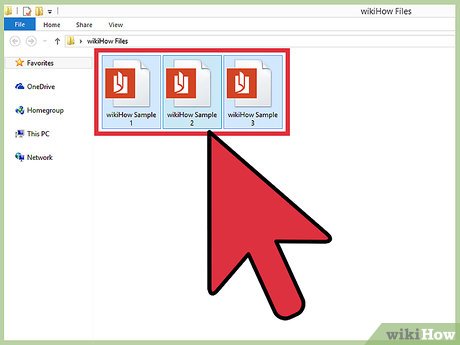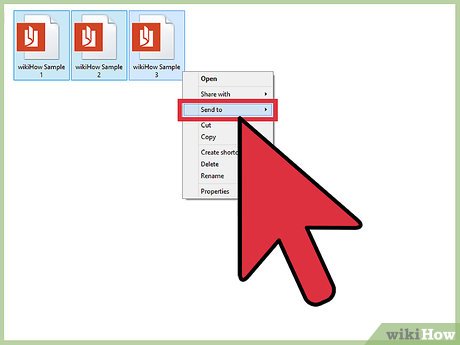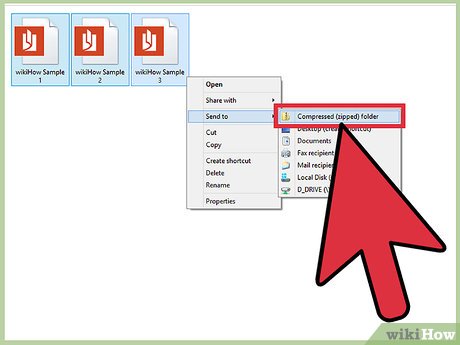How to Zip a File in Windows
Method 1 of 2:
Zipping a File in Windows
-
 Select a file or folder to zip. Locate the file or folder you wish to zip and right-click on it to open the context menu.
Select a file or folder to zip. Locate the file or folder you wish to zip and right-click on it to open the context menu.- In order to select more than one file to zip, press and hold the Ctrl button on the keyboard while clicking each file. Please note, however, that in order to use this, the files or folders need to be located in the same folder.
-
 Select 'Send to.' Another menu will open after clicking this option.
Select 'Send to.' Another menu will open after clicking this option. -
 Zip the file or folder. From the menu given under 'Send to,' select 'Compressed (zipped) folder.' A small icon should appear in the same window with an identical file or folder name, but it will have a zipper on the icon. This means that the file or folder is zipped and ready to go.
Zip the file or folder. From the menu given under 'Send to,' select 'Compressed (zipped) folder.' A small icon should appear in the same window with an identical file or folder name, but it will have a zipper on the icon. This means that the file or folder is zipped and ready to go.- If you would like to add another folder to your new zip folder, simply click and hold on a file or folder, and drag it over the new zip folder. Release the mouse button and the file or folder will be added.
Method 2 of 2:
Zipping a File in Windows Using 7-Zip
-
 Check PC for 32- or 64-bit Version. Before continuing on you will need to know what version of Windows you are running. In order to see this information follow these steps:
Check PC for 32- or 64-bit Version. Before continuing on you will need to know what version of Windows you are running. In order to see this information follow these steps:- For Windows 8, open a file explorer window. On the left-hand side of the window you should see 'This PC.' Right-click it and then hit 'Properties.' A new window should open, and under the subheading 'System,' and to the right of 'System type,' it should say 32- or 64-bit. Remember this for the next step.
- For Windows 7, click the Start orb and right-click 'Computer,' and then click 'Properties.' A new window should open. Under the subheading 'System,' and to the right of System type, it should say 32- or 64-bit. Remember this for the next step.
- For Windows XP, click Start and right-click 'My Computer,' and then click 'Properties.' A new window will pop up with the General tab already selected. To the right of the Windows logo, under the System subheading, you should see Microsoft Windows XP. If there is nothing else next to it. You are running a 32-bit version of Windows XP. If it says 64 next to it, you are running 64-bit version of windows. Remember this for the next step.
-
 Download and install 7-Zip. Open any Internet browser on your PC, and navigate to the 7-Zip download page. There are basically two different download options (32-bit and 64-bit) based on the type of processor your PC is using.
Download and install 7-Zip. Open any Internet browser on your PC, and navigate to the 7-Zip download page. There are basically two different download options (32-bit and 64-bit) based on the type of processor your PC is using.- If you are running a 32 bit version of Windows, the second option from the top will be for you. Click the blue 'Download' button to the left of '.msi' to continue. Once finished, follow the step-by-step install instructions on the screen.
- If you are running a 64 bit version of Windows, the second option from the top will be for you. Click the blue 'Download' button to the left of '.msi' to continue. Once finished follow the step-by-step install instructions on the screen.
-
 Select a file or folder to zip. Locate the file or folder you wish to zip and right-click on it. A context menu should appear.
Select a file or folder to zip. Locate the file or folder you wish to zip and right-click on it. A context menu should appear.- In order to select more than one file to zip, press and hold the Ctrl button on the keyboard while clicking each file. Please note however that in order to use this, the files or folders need to be located in the same folder.
-
 Select '7-Zip Menu.' Another menu will open.
Select '7-Zip Menu.' Another menu will open. -
 Zip the file or folder. From the new menu, select 'Add to 'Folder.zip.' A small icon should appear in the same window with an identical file or folder name, but it will have a 'Z' on the icon. This means that the file or folder is zipped and ready to go.
Zip the file or folder. From the new menu, select 'Add to 'Folder.zip.' A small icon should appear in the same window with an identical file or folder name, but it will have a 'Z' on the icon. This means that the file or folder is zipped and ready to go.- Please note that if there is no 'Z' on the folder icon that is OK. By default, the icon may have a small zipper going down the right-hand side.
4 ★ | 1 Vote
You should read it
- What is a folder The concept of a file (File) and a folder (Folder) in a computer
- How to Lock a Folder on Windows
- How to Set Password for Folder and File in Windows
- How to save files to multiple folders on the web browser
- How to Extract a Gz File
- Open the file, open the folder with a mouse click
- What is the FOUND,000 folder and the file FILE0000.CHK on Windows?
- How to Create JAR File
May be interested
- Top 5 file management software best replace File Explorer on Windows
 the vast majority of windows users use the existing file explorer to manage or move files. this file manager is good enough, and the default is available in windows, but not the best. if you have higher requirements for managing the file system on your computer, then it's time to find a new solution.
the vast majority of windows users use the existing file explorer to manage or move files. this file manager is good enough, and the default is available in windows, but not the best. if you have higher requirements for managing the file system on your computer, then it's time to find a new solution. - 7 notable changes in File Explorer Windows 11
 windows file explorer is one of those areas where microsoft has made some interesting additions that older versions didn't have.
windows file explorer is one of those areas where microsoft has made some interesting additions that older versions didn't have. - Instructions for changing the default PDF file reader application in Windows 10
 if you want to change another program in your computer to open the pdf file instead of using edge in windows 10. in the following article, network administrator will introduce and guide you in two extremely simple ways.
if you want to change another program in your computer to open the pdf file instead of using edge in windows 10. in the following article, network administrator will introduce and guide you in two extremely simple ways. - What is a .tmp file? How to open .tmp file on Windows computer?
 the article provides information about what a tmp file is, how to open a tmp file, how to delete a tmp file and answer frequently asked questions about tmp files. nguyen humanity what is the generated tmp file? let's see it now!
the article provides information about what a tmp file is, how to open a tmp file, how to delete a tmp file and answer frequently asked questions about tmp files. nguyen humanity what is the generated tmp file? let's see it now! - Instructions to edit or replace Boot.ini file on Windows XP
 boot.ini is a hidden file used to identify folders on the partition, and the directory location located on the windows xp hard drive. however, sometimes for some reason the boot.ini file may be damaged, corrupted, or deleted.
boot.ini is a hidden file used to identify folders on the partition, and the directory location located on the windows xp hard drive. however, sometimes for some reason the boot.ini file may be damaged, corrupted, or deleted. - 9 ways to enable File Explorer in Windows 10
 file explorer is a data management tool integrated in windows 10 with many improvements compared to previous windows versions. but few know about nine ways to enable file explorer in windows 10 and here's how.
file explorer is a data management tool integrated in windows 10 with many improvements compared to previous windows versions. but few know about nine ways to enable file explorer in windows 10 and here's how. - How to decompress IMG files in Windows and macOS
 anyone who has ever burned a disc is probably familiar with most disk image file formats. img is one of them, and they are often used to compress programs, such as operating systems, software, or video games.
anyone who has ever burned a disc is probably familiar with most disk image file formats. img is one of them, and they are often used to compress programs, such as operating systems, software, or video games. - What is Pagefile.sys and should it be disabled?
 what is pagefile.sys? what does the page file do on the computer? how does the page file work, should it be disabled on windows?
what is pagefile.sys? what does the page file do on the computer? how does the page file work, should it be disabled on windows? - What is DMP file? How to open DMP files in Windows 10
 there is a large portion of windows system files that are not as easily accessible as others. one of these windows-specific extensions is called a dmp (.dmp) file or a windows memory dump.
there is a large portion of windows system files that are not as easily accessible as others. one of these windows-specific extensions is called a dmp (.dmp) file or a windows memory dump. - Instructions on how to transfer ESD file to ISO for Win XP, 7,8,10
 currently, iso files will often be used to install win for computers. so if you have downloaded the esd file to your computer, you can convert it to an iso file for use.
currently, iso files will often be used to install win for computers. so if you have downloaded the esd file to your computer, you can convert it to an iso file for use.


















 How to Open Device Manager in Windows
How to Open Device Manager in Windows How to Recover a Lost Product Key from Your Windows Operating System
How to Recover a Lost Product Key from Your Windows Operating System How to Handle an SHS File
How to Handle an SHS File How to Search for Text in Files on Windows
How to Search for Text in Files on Windows How to Repair Defective or Missing System Files in Windows
How to Repair Defective or Missing System Files in Windows